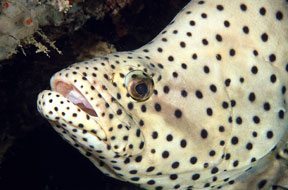Fish faces are favorite subjects for many underwater photographers, but creating compelling fish portraits requires some forethought and the use of the best techniques.
Let’s start with the premise that it is usually best to get in sharp focus every facial feature from the eyes forward. That is usually not a problem if you are photographing a fish with a head that is only a couple of inches long. But in the case of fish that are roughly 10 inches (25.4 cm) long (or longer) as well as those species that have relatively long faces, getting all parts of the face in sharp focus often proves challenging.

Photo by Marty Snyderman
Unless you are photographing sharks or other relatively large fish, you’ll likely be using a macro lens and have a shooting distance of two feet (0.6 m) or less. This combination means that no matter what f-stop you use you will have a relatively narrow depth of field (the area within the bounds of acceptable focus). In essence, the challenge is to get all parts of the face in focus when photographing a fish that has a long face with a lens, f-stop and shooting distance that result in a narrow depth of field.
To cope with the challenge, it is helpful to separate fish face photographs into three categories. One in which the fish’s face is parallel to the camera sensor. A second in which the fish’s face is angled toward the lens. And a third in which the fish is facing the lens head-on. The fish’s orientation to your camera will enable you to determine exactly where you want to focus your lens. This fish’s orientation to the camera becomes more important the longer the fish’s face is.
When a fish is parallel to your sensor, you can focus anywhere on the plane of the fish and achieve the desired result. Things become more problematic when a fish is angled toward your lens. While it is common to read that the proper technique is to focus on the eye, I often “cheat the focus” slightly forward to give me a better chance of getting the parts of the fish’s face (mouth, teeth, etc.) that are closer to my lens in sharp focus along with the eye. Focusing right on the eye often produces images with facial features such as the lips that are closer to the lens being objectionably out of focus.
I also suggest “cheating” your focus point just slightly when a fish is facing the lens head-on. To give yourself the best chance of getting all parts of the face in sharp focus, try focusing on a facial feature that is about two-thirds of the way forward between the eyes and the closest facial features. Being able to close down your aperture will also help increase your depth of field.
Applying these focusing techniques will help you create compelling fish portraits.



